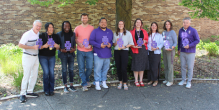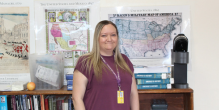Teacher Working Hard in the Tropics
By Julie Quinn Kiernan, Biology and AP Environmental Science Teacher
November 8, 2019
Ten weeks ago I started on a journey to Costa Rica where I would spend the first trimester on a sabbatical from my teaching duties in the science department. When I applied for the sabbatical (CDH offers up to two of these per year to the faculty), my goals were to work in conservation of some kind, learn Spanish better and teach in a Central American school.
So far, I’ve attended Spanish school four hours a day for five weeks (I now understand why my students don’t like homework and get so tired sitting in class all day). I’m also currently working with sea turtles at a very rural beach rescuing turtle eggs from predators and poachers. This experience has been extremely rewarding and exciting for me, considering that I’m a biology teacher and that the baby turtles are so darn cute.
I work with people from all over the world. Currently, our team consists of two German young women, a French man and woman, and me.
For example, Laura, a 19-year-old German woman, is on a gap year, which is common in her country. She will start college in February after traveling to various countries while working with wild animals. “I want to learn about different animals and have an adventure before I begin my studies in chemistry,” she said, adding that the turtle experience has been very rewarding.
Every night, our turtle team goes out on the beach looking for female turtle tracks in the sand. Then we follow them to, hopefully, an adult turtle laying eggs. Turtles, like most reptiles, don’t take care of their eggs after they lay them so the baby turtles will be on their own when they hatch. Unfortunately, before they are able to do that, predators like raccoons come along and dig them up, or even take them while the mother is laying them. Also, humans poach the eggs because they consider them an aphrodisiac (this is not proven in any way). So, if we can get there before any of this happens and take the eggs to a safe place, the babies have a much better chance.
After we find the eggs, we take them back to a protected nursery, until they are ready to hatch. Then, we release the turtles in the ocean.
Why is this important? There are seven types of sea turtles and all of them are endangered. Also, for every 1,000 eggs laid, only one will make it to adulthood. After we release them, turtles have all sorts of problems getting away from fish, avoiding fishing nets and pollution like plastics in the ocean. So helping them in any way increases their chances that they will not go extinct.
Stewart Gomez, the Costa Rican professional at the turtle beach who is in charge of the volunteers, also owns a small farm that he travels to every weekend on his days off. He is working with the turtles not only because it’s a job, but because it’s “rewarding and I feel I am making a difference,” he said.
When I return to CDH, I will be very interested in raising money for this particular turtle beach, so stay tuned for that from the Sustainability Club.
But before I return, I’m also looking forward to three weeks teaching English and serving as a consultant to the science department in a small school here. The students range in age from six to 18, so that it will be a big change for me. I’m sure I’ll be very ready to come back second trimester with new energy and new ideas. Until then, hasta luego!
Subscribe to our e-Newsletters
You might also like:
CDH Honors Faculty and Staff at Annual Year-End Luncheon
At the June 4 luncheon, Cretin-Derham Hall recognized faculty and staff with awards, service milestones, and farewells to this year’s retirees.
Jenn Androsky Voted Senior Division Teacher of the Year for Minnesota History Day
Social Studies teacher Jenn Androsky, now in her 17th year at CDH, was named the Senior Division Teacher of the Year for Minnesota History Day.
President Myers: Students Are the Mission
Greta Cunningham '23 sat down with President Jeb Myers for a Q&A session, focusing on questions from a student's perspective.




